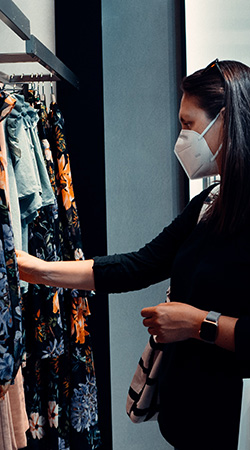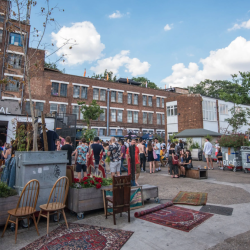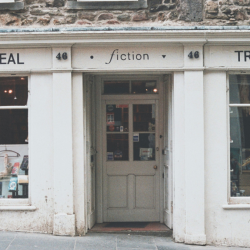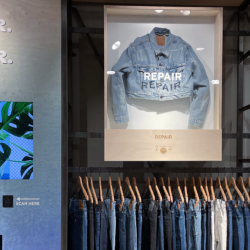Bricks and mortar retail finds itself on the cusp of an interesting opportunity, post-COVID-19. On the one hand, the threat posed to it by ecommerce is bigger than ever. With no other option but to shop online, even the most dedicated high street visitor has been exposed to a more digital way of life.

Yet one of the more striking revelations of lockdown has been consumers’ impatience to be allowed back into physical stores. Queues of people waiting three hours or more to get into JD Sports and Primark show the high street may not be as doomed as we thought. In the immortal words of Joni Mitchell’s ‘Big Yellow Taxi’, “You don’t know what you’ve got ‘til it’s gone”. On this occasion, consumers might have had a near miss.
The fondness for physical retail won’t last, however, without retailers putting some serious thought into what it means to ‘go shopping’. After the initial glee of being released from confinement and the novelty of travelling to shops, online’s convenience and range will once again challenge bricks and mortar.
Retailers need to understand why consumers wanted to head back out, even while the threat of infection remained. It all comes down to experience. Consumers craved not just goods, but entertainment and interaction. The change of scenery, a friendly face – albeit one frequently behind a mask and at a safe distance – and the personal touch are all critical elements. They differentiate the high street from online. Now is retail’s opportunity to claw back that footfall.
From gimmick to goods
Experiential marketing is nothing new but it has often been viewed as a campaign, a promotion or an event. It can be expensive to produce, difficult to scale or a loss leader to boost the brand. Now is the time to make that retail theatre a core revenue generator and a permanent fixture.
YR Store started out as a standalone store in London’s Carnaby Street making personalised, screen printed T-Shirts. Customers would use a digital platform in-store to create their own, one-off design and it would be printed there and then. Then, the company set up an installation in Topshop’s flagship store on New York’s Fifth Avenue. But, it was recognised that this was as much a marketing as a retail exercise. It drummed up interest from potential clients, including those on the conference marketing circuit.
Tim Williams of YR Store explains that their initial concept of creating a direct-to-consumer retail proposition was strong, but not necessarily viable in its early format. “We look back with rose-tinted spectacles and think, were we just too early. We were pioneering interactive retail and, post-COVID, retailers are now focusing on a reason to bring people into stores. From the store in Soho, it was the holy grail of on-demand production and customisation. The reality was that it was difficult to get scale without significant investment. It wasn’t making enough money for it to be exciting.”
That’s not the end of the customisation story however. “We pivoted and ended up doing a B2B offering. We went to Levi’s and said we’ll do it for you and put it in your store under the Levi’s brand.” For Levi’s, YR powered its ‘print bar’ where customers can apply designs to denim. YR has also supported the brand’s past Pride efforts with customisable support tees. YR now works with a wide range of brands on their customisation and experiential needs, including Ralph Lauren and Kenzo. For the latter, the design company set up a pop-up experience in Selfridges. It was the first foray into customisation services for the Japanese fashion house.
Memorable moments to take away
Building an in-store experience isn’t about fireworks, it’s about making the moment matter. For most consumers, that comes down to personalisation in any one of its many forms.
Aaron Shields is executive strategy director at Fitch, a global brand and retail consultancy. “How do you get people to spend more quality time in-store? They’re already open to buying, how do you make that time as special as possible? The real experience is about getting a memento of the time they’ve had,” he suggests.
Shields reveals that the in-store experience at Lego is all designed around creating memorable moments of varying complexity. This is vital because, as Williams points out, high level personalisation and in-store experience can be time-consuming, expensive and not revenue-generating.
At Lego, the brick wall at the back allows customers to ‘self-serve’ their personalised experience with a pick ‘n’ mix of the bricks. Or, they can move to the Minifigure Factory to make a figure, either with the existing options available, or move it up a notch to print their own, bespoke face. That level requires a little staff input but is still a light touch operation.

Building blocks of success
“That’s a huge profit centre for them and it’s low cost which everyone understands how to do. It’s easy, accessible personalisation whether you want a souvenir or just to give your child a treat,” Shields explains. “Then, there’s the higher order of personalisation. You can create a mosaic made out of Lego bricks from a picture of yourself. It retails for £100 which is not cheap but it’s really popular.”
Shields adds that the higher end personalisation offerings could suffer from a number of challenges. On the one hand, they are time-consuming and labour intensive, hence the high price point. That high price point may be off-putting or simply unattainable for the majority of shoppers. This could cause negative feelings, the opposite of what a personalised experience is trying to achieve.
Because it is time-consuming , there is a limit on the number of mosaics that can be produced. Some potential customers may be disappointed. The trick, Shields suggests, is in the variety of personalisation on offer. “Sometimes something so popular has to be constrained and you can upset people who can’t access it. Having a spectrum of different personalisation types is a great way to make sure that, if you don’t have the time or money, you can get something else instead.”
Simplify the customer’s day-to-day
You could argue that it’s not difficult to turn something as aspirational or entertaining as fashion and toys into an experience. That oft-quoted aim to ‘surprise and delight’ customers seems easier to achieve in these contexts. But it’s still eminently possible to deliver great personalisation that elevates the customer experience and boosts the bottom line, even in the most mundane of sectors.
Sheilds mentions previous work with Carphone Warehouse which was struggling at the bottom of customer service league tables. The mobile phone industry is notorious for its baffling array of product combinations. Consumers may also worry about making the wrong decision and getting stuck with it for two or even three years.
“The company built this tool that helps get across the notion of impartial advice. A simple tablet that asks questions such as where you live (for network coverage) and what you use it for (data needs) narrows the choice down to the three most appropriate packages. It brought Carphone Warehouse from the bottom of the table to the top. This wasn’t complicated. It didn’t require a lot of training and performed hugely for them in terms of service differentiation,” he reveals.
At its most basic, great experiences through personalisation come down to smoothing the customer’s path through a cluttered, noisy existence. Something as simple as making the daily shop less of a bind can dramatically improve their perception of your brand.
Wish for a better experience
Finnish grocery chain, S Group (SOK), discovered this when it explored how to help its flagship convenience store brand, Alepa, stand out in a competitive marketplace. Research showed that the brand was perceived as somewhat rigid. Customers had little say in what was on the shelves, despite its own positioning as a helpful local store. Initially, 25% thought Alepa’s competitors were better at serving individual customer’s needs and only 9% thought Alepa could do this. In 2018, the company launched its ‘Block Wish’ bot to counter this.
Running on Facebook Messenger, the chatbot allowed Alepa customers to access the parent’ company’s whole inventory. This is a product selection 10 times larger than what is available via Alepa stores. If the customer finds a brand of orange juice they would like but that is not stocked in their local branch, they can send a ‘Wish’. In anything between two days to one week, the product arrives on the shelf in the customer’s store. Not in any other store (unless it’s wished elsewhere), just that one.
“We wanted consumers to feel that, whatever they need, they can get it from their Alepa store. We can automate the process. It’s easier for the shopkeeper to manage and it doesn’t increase workload much,” insists SOK’s head of marketing strategy, Janne Lehtinen. “This is now a feature in our corner store concept. Not as a marketing campaign, it’s just something that they do.”
Manage expectations
Lehtinen reveals that each location across its 100-store network gets an average of one wish per day, a level he says is “manageable”. That each item that has been wished is promoted as a Block Wish product on the shelf adds to its allure. Alepa finds that it is able to sell it at a premium, doubling down on the personalisation benefit.
“We label those products so that consumers who haven’t used Block Wish can see that it works. They usually grab that product more easily compared to others in the category and we can keep that price point higher. It sounds minor but if you extrapolate that through larger volumes, you increase the profitability of those products,” Lehtinen says.
The performance of the project has, overall, been stellar. One years in, there had been 150,000 product wishes with 70% fulfilled within 48 hours. Up to 25% of an Alepa store selection is from Block Wish. Its brand measures rose significantly with the statement “Selection fits my needs” rising 12 points and “Alepa actively improves its services” up nine points.”
Lehtinen reveals that, in rerunning the question of whether or not customers felt they could influence the store’s selection, 52% believed they could with Alepa. Its closest competitor remained at 25%: “We beat them at their own game,” he says.
Building on experience is not a silver bullet for bricks and mortar retail. Brands will continue to have to work hard to maintain both relevance and a workable business model in the omnichannel. But consumer behaviour, particularly as countries emerged from lockdown, has revealed that ecommerce-only doesn’t satisfy every need. There is still demand for a physical retail experience, it just has to be one worth travelling for.
Featured image: watermelontart / Shutterstock.com































